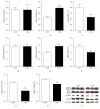Neuroplastic Correlates in the mPFC Underlying the Impairment of Stress-Coping Ability and Cognitive Flexibility in Adult Rats Exposed to Chronic Mild Stress during Adolescence
- PMID: 28182105
- PMCID: PMC5274659
- DOI: 10.1155/2017/9382797
Neuroplastic Correlates in the mPFC Underlying the Impairment of Stress-Coping Ability and Cognitive Flexibility in Adult Rats Exposed to Chronic Mild Stress during Adolescence
Abstract
Using a valid chronic mild stress (CMS) model of depression, we found that adolescent (postnatal days [PND] 28-41) CMS induced transient alterations in anhedonia that did not persist into adulthood after a 3-week recovery period. Previously stressed adult rats exhibited more immobility/despair behaviors in the forced swimming test and a greater number of trials to reach criterion in the set-shifting task, suggesting the impaired ability to cope with stressors and the cognitive flexibility that allows adaptation to dynamic environments during adulthood. In addition, adult rat exposure to adolescent CMS had a relatively inhibited activation in ERK signaling and downstream protein expression of phosphorylated cAMP-response element-binding protein (CREB) and brain-derived neurotrophic factor (BDNF) in the medial prefrontal cortex. Further correlation analysis demonstrated that immobility and set-shifting performance were positively correlated with the inhibition of ERK signaling. These results indicated adolescent CMS can be used as an effective stressor to model an increased predisposition to adult depression.
Conflict of interest statement
The authors declare no potential conflict of interests in this research.
Figures





Similar articles
-
Region-Dependent Alterations in Cognitive Function and ERK1/2 Signaling in the PFC in Rats after Social Defeat Stress.Neural Plast. 2018 Apr 11;2018:9870985. doi: 10.1155/2018/9870985. eCollection 2018. Neural Plast. 2018. PMID: 29849577 Free PMC article.
-
Piromelatine ameliorates memory deficits associated with chronic mild stress-induced anhedonia in rats.Psychopharmacology (Berl). 2016 Jun;233(12):2229-39. doi: 10.1007/s00213-016-4272-3. Epub 2016 Mar 23. Psychopharmacology (Berl). 2016. PMID: 27007604
-
Resveratrol prevents impaired cognition induced by chronic unpredictable mild stress in rats.Prog Neuropsychopharmacol Biol Psychiatry. 2014 Mar 3;49:21-9. doi: 10.1016/j.pnpbp.2013.10.017. Epub 2013 Oct 31. Prog Neuropsychopharmacol Biol Psychiatry. 2014. PMID: 24184538
-
A kinase with a vision: Role of ERK in the synaptic plasticity of the visual cortex.Adv Exp Med Biol. 2006;557:122-32. doi: 10.1007/0-387-30128-3_7. Adv Exp Med Biol. 2006. PMID: 16955707 Review. No abstract available.
-
Coping with the forced swim stressor: Current state-of-the-art.Behav Brain Res. 2019 May 17;364:1-10. doi: 10.1016/j.bbr.2019.02.005. Epub 2019 Feb 6. Behav Brain Res. 2019. PMID: 30738104 Review.
Cited by
-
Impact of stress on excitatory and inhibitory markers of adolescent cognitive critical period plasticity.Neurosci Biobehav Rev. 2023 Oct;153:105378. doi: 10.1016/j.neubiorev.2023.105378. Epub 2023 Aug 27. Neurosci Biobehav Rev. 2023. PMID: 37643681 Free PMC article. Review.
-
Brain region-specific roles of brain-derived neurotrophic factor in social stress-induced depressive-like behavior.Neural Regen Res. 2025 Jan 1;20(1):159-173. doi: 10.4103/NRR.NRR-D-23-01419. Epub 2024 Apr 3. Neural Regen Res. 2025. PMID: 38767484 Free PMC article.
-
Morphological Responses of Excitatory Prelimbic and Orbitofrontal Cortical Neurons to Excess Corticosterone in Adolescence and Acute Stress in Adulthood.Front Neuroanat. 2020 Sep 8;14:45. doi: 10.3389/fnana.2020.00045. eCollection 2020. Front Neuroanat. 2020. PMID: 33013327 Free PMC article.
-
Chronic unpredictable stress during adolescence protects against adult traumatic brain injury-induced affective and cognitive deficits.Brain Res. 2021 Sep 15;1767:147544. doi: 10.1016/j.brainres.2021.147544. Epub 2021 Jun 4. Brain Res. 2021. PMID: 34090883 Free PMC article.
-
Adolescent Corticosterone and TrkB Pharmaco-Manipulations Sex-Dependently Impact Instrumental Reversal Learning Later in Life.Front Behav Neurosci. 2017 Dec 7;11:237. doi: 10.3389/fnbeh.2017.00237. eCollection 2017. Front Behav Neurosci. 2017. PMID: 29270114 Free PMC article.
References
Publication types
MeSH terms
Substances
LinkOut - more resources
Full Text Sources
Other Literature Sources
Medical
Miscellaneous

